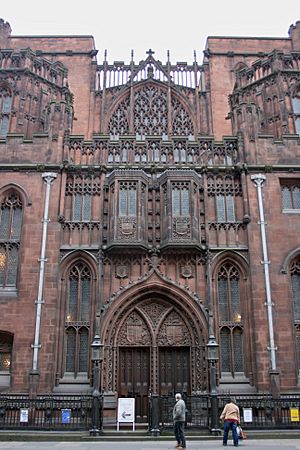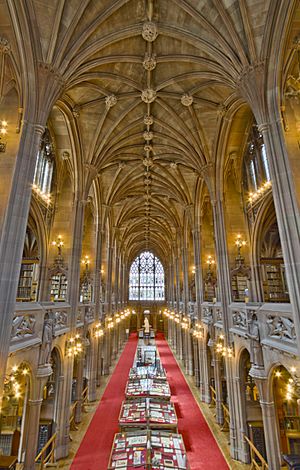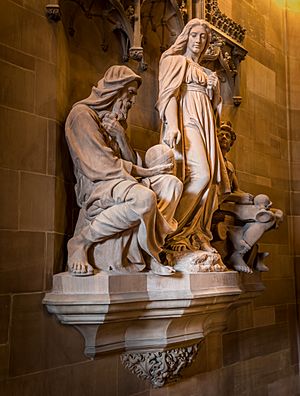John Rylands Research Institute and Library facts for kids
Quick facts for kids John Rylands Research Institute and Library |
|
|---|---|
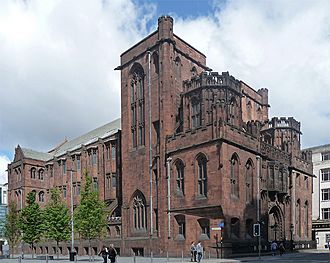 |
|
| Alternative names | Rylands |
| General information | |
| Type | Library |
| Architectural style | Victorian Neo-Gothic |
| Location | Deansgate, Manchester, England |
| Coordinates | 53°28′49″N 2°14′55″W / 53.480321°N 2.2487°W |
| Construction started | 1890 |
| Completed | 1899 |
| Opened | 1 January 1900 |
| Inaugurated | 6 October 1899 |
| Renovated | 1920, 1962, 2003–07 |
| Cost | £200,000 |
| Owner | University of Manchester |
| Design and construction | |
| Architect | Basil Champneys |
| Main contractor | R. and W. Morrison, Liverpool |
| Designations | |
|
Listed Building – Grade I
|
|
| Official name: John Rylands Library and attached railings, gates and lamp standards | |
| Designated: | 25 January 1952 |
| Reference #: | 1217800 |
The John Rylands Research Institute and Library is an amazing old building in Manchester, England. It looks like a grand, old church or castle. It was built a long time ago, during the Victorian era, and has a special style called neo-Gothic.
This library is now part of the University of Manchester. It first opened its doors to the public in 1900. A woman named Enriqueta Augustina Rylands built it to remember her husband, John Rylands.
Today, the library holds many of the university's "Special Collections." These are very old and rare books, manuscripts, and other important items. It's one of the biggest collections of its kind in the United Kingdom.
Some of the treasures inside include:
- Beautiful medieval illuminated manuscripts (hand-written books with amazing drawings).
- Very early printed books from Europe, like a Gutenberg Bible.
- The second largest collection of books printed by William Caxton, one of England's first printers.
- The Rylands Library Papyrus P52, which might be the oldest piece of the New Testament ever found.
- Personal letters and papers from famous people like the writer Elizabeth Gaskell and the scientist John Dalton.
The building itself is a work of art. It has a unique style that mixes neo-Gothic with Arts and Crafts movement details. It's so important that it has a special "Grade I listed status," meaning it's a building of great historical interest. The University of Manchester takes care of it, and you can visit it as a library reader or a tourist.
Contents
History of the Library
How the Library Started
Enriqueta Rylands bought the land for her special library in 1889. She hired an architect named Basil Champneys to design it. Mrs. Rylands wanted the library to focus mainly on religious books. The building ended up looking a lot like a church, but it was designed to be a grand library, similar to those at Oxford University.
Champneys quickly drew up plans. Mrs. Rylands was very involved in the design. She often chose decorations, window glass, and statues, even if the architect didn't agree.
The library was officially opened on October 6, 1899. It welcomed its first readers and visitors on January 1, 1900. When Mrs. Rylands passed away in 1908, the library already had over 50,000 amazing books.
Growing the Collections
The main part of the library's collection came from about 40,000 rare books. These were collected by George Spencer, 2nd Earl Spencer. Mrs. Rylands bought this huge collection in 1892. She also bought over 6,000 old manuscripts from James Lindsay, 26th Earl of Crawford in 1901. These purchases made the Rylands Library instantly famous for its incredible collection.
Over the years, the library continued to grow. Thanks to gifts and money left by Mrs. Rylands, it added many more books and manuscripts.
Becoming Part of the University
In July 1972, the John Rylands Library joined with the University of Manchester Library. It was then called the John Rylands University Library of Manchester. This merger brought together even more special collections into the Deansgate building.
Building Changes Over Time
The library building has been made bigger four times. The first addition was in 1920. A new building, the Lady Wolfson Building, opened in 1962. Another extension was built in 1969.
In 2003, a big project called "Unlocking the Rylands" began. It cost £17 million to make the building even better. They removed one of the older extensions, fixed up parts of the original building, and added a proper pitched roof. The library reopened in September 2007.
More recently, in February 2024, a £7.6 million plan was announced to upgrade the library again. This project, called 'John Rylands Next Chapter', will make "sensitive adaptations" to update the building.
Location and Design Challenges
In the 1800s, Manchester was a busy industrial city. It was known for its cotton factories. This meant the air was often dirty with smoke and soot. The spot Mrs. Rylands chose for the library was in the city center, but it was a tricky shape and surrounded by tall buildings.
The architect, Basil Champneys, had to be clever. He designed the building with steps and a nearly flat roof. This helped allow light into the library, even with the tall buildings around it. He also thought about how to keep the valuable books safe from the dirty city air.
Architecture and Style
Outside the Library
The library was built in a rectangular shape. It looks like a church with its decorated neo-Gothic style. The outside is made of dark red sandstone from Penrith, which was an unusual choice for Manchester.
The front of the library, facing Deansgate, is very fancy. It has a central entrance that looks like a monastery gate. There are two tall windows on each side of the doors. The walls are covered with detailed carvings and patterns. These carvings include the initials "J. R." for John Rylands and the symbols of different universities.
On either side of the entrance are square towers with large, round lanterns on top. In front of the library, there are beautiful bronze railings and lamp posts in an Art Nouveau style.
Inside the Library
The main reading room is on the first floor. It's known for being very quiet and peaceful, a big contrast to the busy city outside. Light comes in through special windows in the reading areas and high windows along the sides.
The reading room is decorated with:
- Two large stained glass windows showing important religious and historical figures.
- Many statues by Robert Bridgeman and Sons.
- Bronze decorations in the Art Nouveau style.
The statues and stained glass show 60 different people from history, including thinkers, artists, and religious leaders. There are also white marble statues of John and Enriqueta Rylands in the reading room.
Besides the main reading room, the library has special rooms for Bibles and maps. There are also rooms for meetings and lectures on the ground floor.
Smart Technology for its Time
The library was one of the first public buildings in Manchester to use electric lighting. This was chosen because it was cleaner and safer than gas. For many years, the library even made its own electricity!
The architect also thought about how to protect the books from the dirty city air. He designed a special ventilation system. It used screens and water sprays to clean the air before it came into the building. This was a very advanced system for that time. There were also special doors to keep the clean air inside.
Amazing Collections
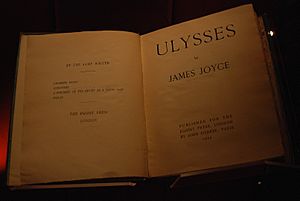
When it opened in 1900, the library had 70,000 books and fewer than 100 manuscripts. By 2012, it had grown to over 250,000 printed books and more than a million manuscripts and other items!
The most important part of the collection is the Althorp Library. This was Lord Spencer's collection of 43,000 items, including 3,000 books printed before 1501. Mrs. Rylands paid a lot of money for this collection in 1892. It included a Gutenberg Bible and many other very early printed books.
Other important additions include:
- Over 6,000 manuscripts bought from James Lindsay, 26th Earl of Crawford in 1901.
- More than 8,000 rare books from the Renaissance period, given by Richard Copley Christie in 1901.
- 5,000 early Italian books from Walter Llewellyn Bullock in the 1930s.
The library also has many ancient papyrus fragments from North Africa. The most famous is the St John Fragment (Rylands Library Papyrus P52). Many people believe this is the oldest piece of the New Testament text that still exists.
The library also collects important historical records. For example, it holds the archives of the Methodist Church of Great Britain. In 2022, the British Pop Archive opened here, which is a national collection about popular culture.
Staff and Research
Important People at the Library
Many important people have worked at the John Rylands Library. Early librarians included Edward Gordon Duff and Henry Guppy. Henry Guppy started the Bulletin of the John Rylands Library in 1903, which became a journal for academic articles.
During World War I, 11 staff members joined the armed forces. Sadly, one of them, Captain O. J. Sutton, lost his life. Other notable staff members include scholars like Alphonse Mingana and Edward Robertson.
The John Rylands Research Institute
The John Rylands Research Institute was started in 1987. It was relaunched in 2013 to encourage and support research using the library's special collections. The Institute works with researchers from Manchester and around the world.
In March 2021, the John Rylands Research Institute and The John Rylands Library officially joined together. They are now known as the John Rylands Research Institute and Library.
Visitors to the Library
Many famous people have visited the library over the years. This includes important leaders and even King Charles III and Queen Camilla (when they were The Prince of Wales and The Duchess of Cornwall).
Images for kids
-
First edition of Ulysses by James Joyce


